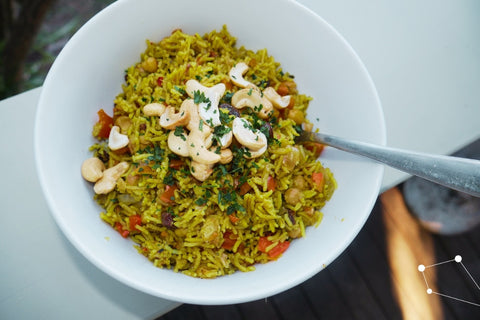(GF, DF, V)
Serves: 6
Time: 45-60 minutes
INGREDIENTS
⊕ 2 cups brown basmati rice
⊕ 2 tbsp olive oil (can use ghee or coconut oil)
⊕ 1 large onion (sliced thinly)
⊕ 1 red capsicum (sliced thinly)
⊕ 2-3 carrots (diced)
⊕ 4 garlic cloves (chopped roughly)
⊕ 2 tsp fresh ginger (grated)
⊕ 1 tbsp cumin
⊕ 1 tbsp coriander
⊕ 1 tsp chilli powder
⊕ 1 tsp cinnamon
⊕ ½ tsp cardamom
⊕ ½ tsp ground turmeric
⊕ 2 bay leaves
⊕ 1 star anise pod (optional)
⊕ 4 cups of vegetable stock
⊕ ¾ tsp salt
⊕ 1 can chickpeas, drained and rinsed
⊕ ½ cup raisins
Garnish: ¼ cup cashews and chopped parsley or coriander
METHOD
- Pour rice into a glass bowl and soak with hot water while you prepare the remainder of the ingredients
- In a large fry pan, heat the oil over medium-high heat. Add chopped onion and saute until brown and tender. Reduce heat to medium and add the chopped vegetables, garlic, ginger and continue to saute for about 4-5 minutes. Remove 1 cup of the mixture from the pan and set aside.
- Add the rest of the spices, bay leaves and stir through for another minute. Drain the rice and add it to the pan with the vegetable stock and salt
- Add the chickpeas, raisins and the cup of vegetables that was placed aside. Bring the mixture to a simmer. Cover the pot with a thin towel and place a lid over the top, bringing the four corners of the towel up and over the lid. This technique helps to keep the steam in and cooks the rice quickly and evenly.
- Continue to simmer on low for 20-30 minutes or until the rice has soaked up the liquid.
- Once cooked, fluff the biryani with a fork, top with cashews and coriander/parsley and serve
Rice has been consumed by many different cultures throughout the world for thousands of years. It is considered to be an unique crop due to its ability to be grown in wet environments where other crops cannot. To this day, rice feeds more than half of the world's population. Rice, which is naturally gluten free, is a source of carbohydrates, protein, dietary fibre, unsaturated fats, bioactive compounds, vitamins, minerals and micronutrients such as thiamine (B1), riboflavin, nicotinic acid, folic acid, vitamin E, calcium, iron and zinc. Brown rice also includes selenium, magnesium and manganese that help to play a role in the prevention of type II diabetes, colon cancer and asthma.
1. Gross, B. L., & Zhao, Z. (2014). Archaeological and genetic insights into the origins of domesticated rice. Proceedings of the National Academy of Sciences of the United States of America, 111(17), 6190–6197. https://doi.org/10.1073/pnas.1308942110
2. Lee JS, Sreenivasulu N, Hamilton RS, Kohli A. Brown Rice, a Diet Rich in Health Promoting Properties. J Nutr Sci Vitaminol (Tokyo). 2019;65(Supplement):S26-S28. doi: 10.3177/jnsv.65.S26. PMID: 31619639.
3. Saleh ASM, Wang P, Wang N, Yang L, Xiao Z. Brown Rice Versus White Rice: Nutritional Quality, Potential Health Benefits, Development of Food Products, and Preservation Technologies. Compr Rev Food Sci Food Saf. 2019 Jul;18(4):1070-1096. doi: 10.1111/1541-4337.12449. Epub 2019 Jun 4. PMID: 33336992.


